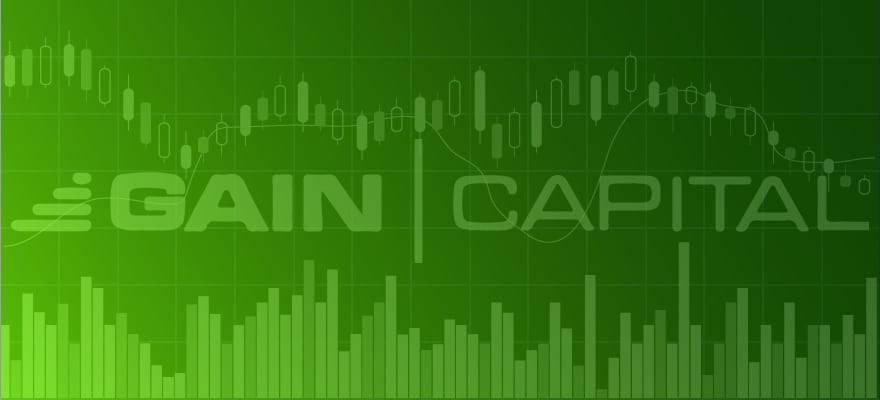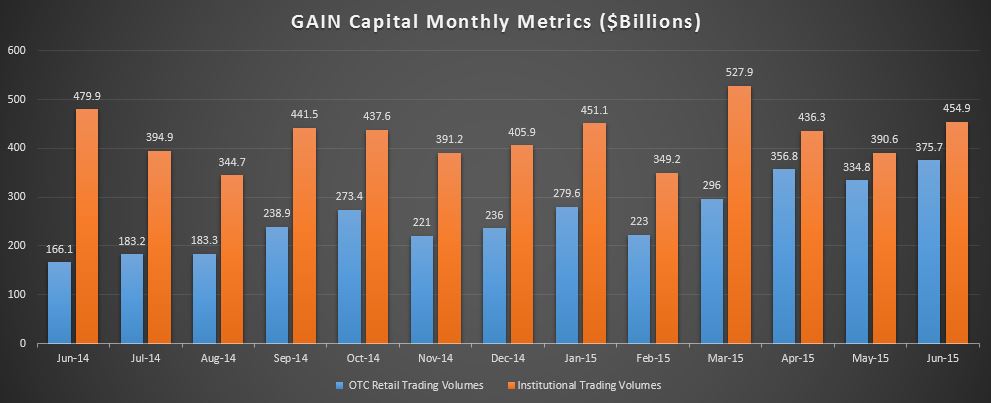GAIN Capital Retail and Institutional Trading Volumes up MoM in June
- Futures contracts reached 695,911, an increase of 2.7% MoM from May 2015 and 34.2% YoY from June 2014.

GAIN Capital Holdings, Inc. (NYSE: GCAP) has just published its monthly metrics including trading volumes for the month of June 2015 and the figures are higher than in May.
The retail yearly figures are much more impressive than the monthly ones, but are due to the fact that the company integrated the metrics of its Acquisition Acquisition Acquisition means acquiring or taking possession or the securing of property, services, or abilities. To put it simply, it is the act or process of acquiring or gaining. You can acquire a work of art, you can acquire an ability such as speaking another language, you can acquire a business or shares in a company and you can acquire an accountant's service. For example, you can acquire a new car. In a broad sense, Acquisition can mean the act of taking ownership or possession of something. There Acquisition means acquiring or taking possession or the securing of property, services, or abilities. To put it simply, it is the act or process of acquiring or gaining. You can acquire a work of art, you can acquire an ability such as speaking another language, you can acquire a business or shares in a company and you can acquire an accountant's service. For example, you can acquire a new car. In a broad sense, Acquisition can mean the act of taking ownership or possession of something. There Read this Term, City Index, since the first consolidated metrics were published in April 2015.
Retail OTC trading volume reached $375.7 billion, an increase of 12.2% MoM from May 2015 and 126.2% YoY from June 2014. Average daily retail OTC trading reached a volume of $17.1 billion, an increase of 7.1% MoM from May 2015 and 115.9% YoY from June 2014. Active retail OTC accounts climbed slightly to 148,730, an increase of 0.8% MoM from May 2015 and 57.8% YoY from June 2014.
Total institutional trading volume is reported at $454.9 billion, an increase of 16.5% MoM from May 2015 and a decrease of 5.2% YoY from June 2014. Average daily institutional volume came in at $20.7 billion, an increase of 11.2% MoM from May 2015 and a decrease of 9.5% YoY from June 2014. GTX trading volume is reported at $418.8 billion, an increase of 16.0% MoM from May 2015 and a decrease of 6.1% YoY from June 2014. Average daily GTX volume came in at $19.0 billion, an increase of 10.7% MoM from May 2015 and a decrease of 10.4% YoY from June 2014.
Futures contracts reached 695,911, an increase of 2.7% MoM from May 2015 and 34.2% YoY from June 2014. Average daily futures contracts reported at 31,632, a decrease of 6.6% from May 2015 and an increase of 28.1% from June 2014.
"GAIN's operating metrics continue to exhibit positive monthly and annual growth following the closing of our acquisition of City Index on April 1. In our retail business, volumes increased 12.2% in June from the prior month and average daily volume reached a new high of $17.1 billion. Retail revenue capture during the quarter was challenging, however, coming in towards the lower end of the range of the last four quarters, which was $70 to $116 per million, primarily due to lower Volatility Volatility In finance, volatility refers to the amount of change in the rate of a financial instrument, such as commodities, currencies, stocks, over a given time period. Essentially, volatility describes the nature of an instrument’s fluctuation; a highly volatile security equates to large fluctuations in price, and a low volatile security equates to timid fluctuations in price. Volatility is an important statistical indicator used by financial traders to assist them in developing trading systems. Traders In finance, volatility refers to the amount of change in the rate of a financial instrument, such as commodities, currencies, stocks, over a given time period. Essentially, volatility describes the nature of an instrument’s fluctuation; a highly volatile security equates to large fluctuations in price, and a low volatile security equates to timid fluctuations in price. Volatility is an important statistical indicator used by financial traders to assist them in developing trading systems. Traders Read this Term in indices and commodities. The integration of City Index is on track, and we expect to achieve the previously disclosed annual run-rate cost savings of $40-$45 million by 2017," remarked Glenn Stevens, Chief Executive Officer.

GAIN Capital Holdings, Inc. (NYSE: GCAP) has just published its monthly metrics including trading volumes for the month of June 2015 and the figures are higher than in May.
The retail yearly figures are much more impressive than the monthly ones, but are due to the fact that the company integrated the metrics of its Acquisition Acquisition Acquisition means acquiring or taking possession or the securing of property, services, or abilities. To put it simply, it is the act or process of acquiring or gaining. You can acquire a work of art, you can acquire an ability such as speaking another language, you can acquire a business or shares in a company and you can acquire an accountant's service. For example, you can acquire a new car. In a broad sense, Acquisition can mean the act of taking ownership or possession of something. There Acquisition means acquiring or taking possession or the securing of property, services, or abilities. To put it simply, it is the act or process of acquiring or gaining. You can acquire a work of art, you can acquire an ability such as speaking another language, you can acquire a business or shares in a company and you can acquire an accountant's service. For example, you can acquire a new car. In a broad sense, Acquisition can mean the act of taking ownership or possession of something. There Read this Term, City Index, since the first consolidated metrics were published in April 2015.
Retail OTC trading volume reached $375.7 billion, an increase of 12.2% MoM from May 2015 and 126.2% YoY from June 2014. Average daily retail OTC trading reached a volume of $17.1 billion, an increase of 7.1% MoM from May 2015 and 115.9% YoY from June 2014. Active retail OTC accounts climbed slightly to 148,730, an increase of 0.8% MoM from May 2015 and 57.8% YoY from June 2014.
Total institutional trading volume is reported at $454.9 billion, an increase of 16.5% MoM from May 2015 and a decrease of 5.2% YoY from June 2014. Average daily institutional volume came in at $20.7 billion, an increase of 11.2% MoM from May 2015 and a decrease of 9.5% YoY from June 2014. GTX trading volume is reported at $418.8 billion, an increase of 16.0% MoM from May 2015 and a decrease of 6.1% YoY from June 2014. Average daily GTX volume came in at $19.0 billion, an increase of 10.7% MoM from May 2015 and a decrease of 10.4% YoY from June 2014.
Futures contracts reached 695,911, an increase of 2.7% MoM from May 2015 and 34.2% YoY from June 2014. Average daily futures contracts reported at 31,632, a decrease of 6.6% from May 2015 and an increase of 28.1% from June 2014.
"GAIN's operating metrics continue to exhibit positive monthly and annual growth following the closing of our acquisition of City Index on April 1. In our retail business, volumes increased 12.2% in June from the prior month and average daily volume reached a new high of $17.1 billion. Retail revenue capture during the quarter was challenging, however, coming in towards the lower end of the range of the last four quarters, which was $70 to $116 per million, primarily due to lower Volatility Volatility In finance, volatility refers to the amount of change in the rate of a financial instrument, such as commodities, currencies, stocks, over a given time period. Essentially, volatility describes the nature of an instrument’s fluctuation; a highly volatile security equates to large fluctuations in price, and a low volatile security equates to timid fluctuations in price. Volatility is an important statistical indicator used by financial traders to assist them in developing trading systems. Traders In finance, volatility refers to the amount of change in the rate of a financial instrument, such as commodities, currencies, stocks, over a given time period. Essentially, volatility describes the nature of an instrument’s fluctuation; a highly volatile security equates to large fluctuations in price, and a low volatile security equates to timid fluctuations in price. Volatility is an important statistical indicator used by financial traders to assist them in developing trading systems. Traders Read this Term in indices and commodities. The integration of City Index is on track, and we expect to achieve the previously disclosed annual run-rate cost savings of $40-$45 million by 2017," remarked Glenn Stevens, Chief Executive Officer.

